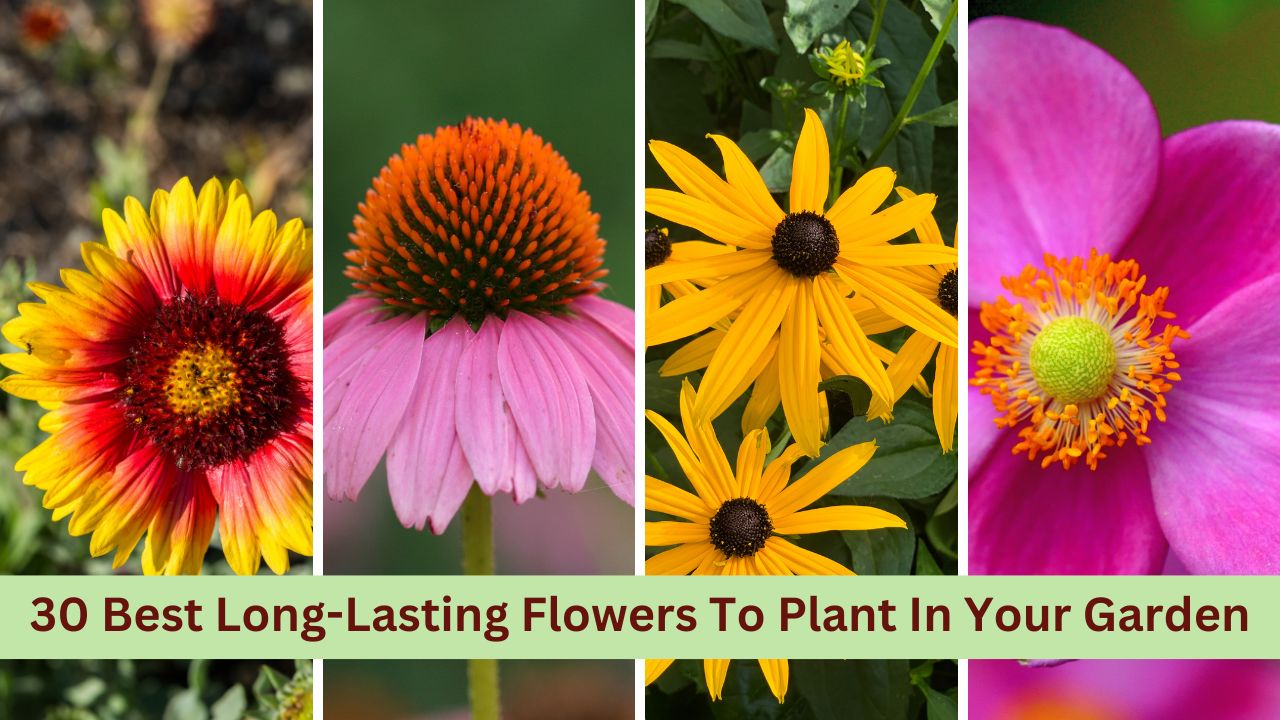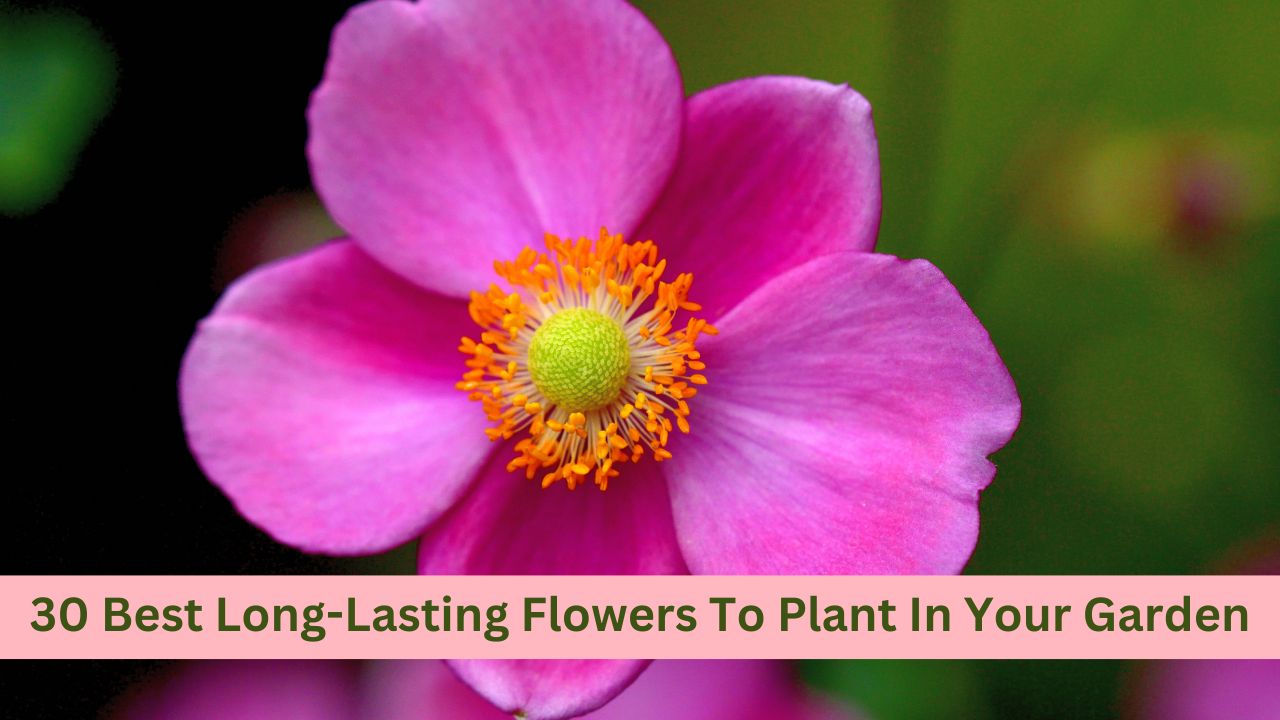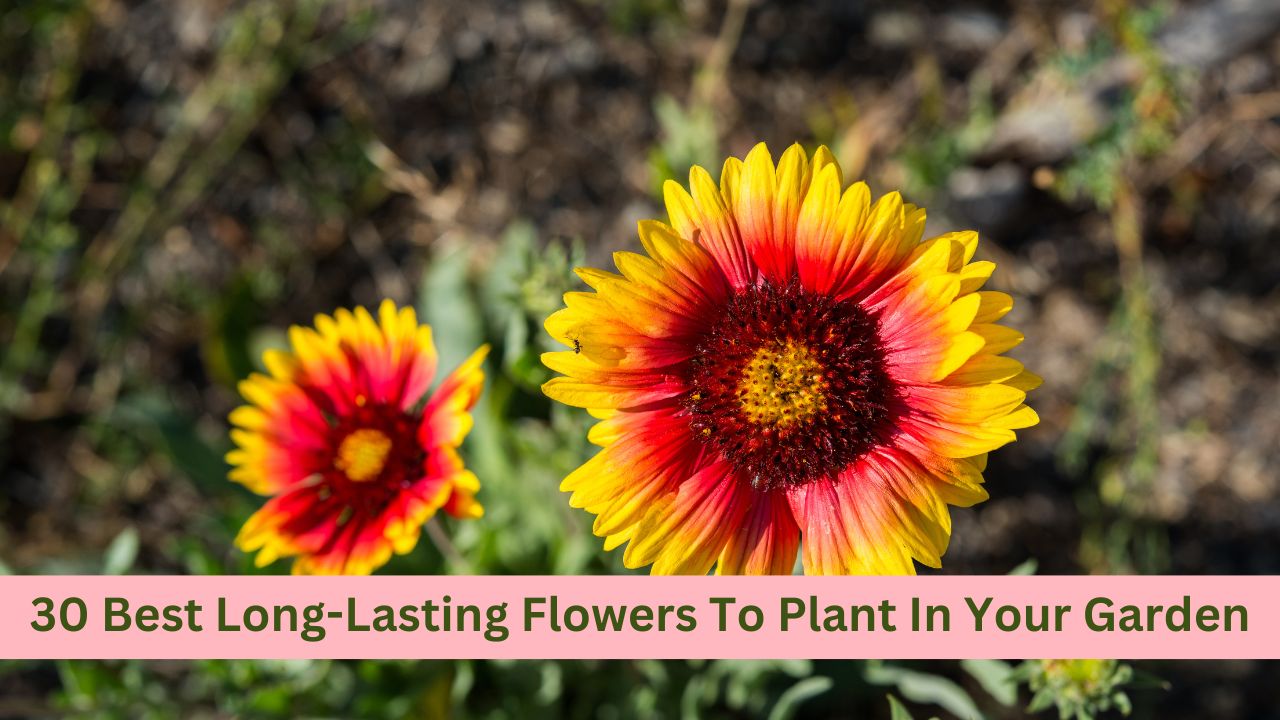30 Best Long-Lasting Flowers To Plant In Your Garden
Creating a garden that boasts long-lasting blooms requires carefully selecting flowers known for their resilience and enduring beauty. When planning your garden, consider opting for perennial plants that add vibrant colors and return year after year, reducing the need for frequent replanting.
Perennials are celebrated for their ability to withstand seasonal changes and harsh weather conditions, ensuring a garden that remains visually appealing throughout the year. These enduring blooms establish a foundation for a low-maintenance yet striking landscape, allowing gardeners to invest time and effort in other aspects of garden care.
Choosing flowers with extended blooming periods is essential for a continuous burst of color. Some varieties are specifically known for their prolonged flowering season, offering a dynamic display from spring through fall. This careful selection ensures that your garden remains in bloom for an extended period, captivating onlookers and providing a haven for pollinators.
In addition to their longevity, long-lasting flowers contribute to the overall health of the garden ecosystem. Their extended bloom times offer sustenance for pollinators, supporting biodiversity and creating a harmonious environment. With thoughtful planning and the inclusion of enduring blossoms, your garden can become a vibrant, ever-changing tapestry of colors that stands the test of time.
30 Best Long-Lasting Flowers To Plant In Your Garden

1. Rudbeckia (Black-Eyed Susan)
Known for its cheerful golden-yellow petals surrounding a dark central cone, this perennial blooms from mid-summer to fall, attracting butterflies and bees.
2. Lavender (Lavandula)
Fragrant and drought-tolerant, lavender offers spiky purple blooms from late spring to early summer, adding a touch of elegance to the garden.
3. Coneflower (Echinacea)
Vibrant and hardy, coneflowers produce bold daisy-like blooms in various hues from early summer to fall, thriving in well-drained soil.
4. Daylily (Hemerocallis)
With a wide range of colors, daylilies bloom from late spring to fall, requiring minimal care and creating a stunning display in borders.
5. Coreopsis
These bright, daisy-like flowers come in various colors, blooming throughout summer and into fall, attracting pollinators with their vibrant hues.
6. Sedum (Stonecrop)
Succulent-like sedums offer clusters of star-shaped flowers in late summer and fall, thriving in dry conditions and providing winter interest.
7. Yarrow (Achillea)
Feathery foliage accompanies flat-topped flower clusters in various colors, making yarrow a drought-tolerant perennial that blooms from late spring to early fall.
8. Peony (Paeonia)
Known for their large, showy blooms, peonies grace the garden in late spring to early summer, thriving in well-drained soil and cooler climates.
9. Shasta Daisy (Leucanthemum)
Classic and timeless, Shasta daisies produce white blooms with yellow centers from late spring to early fall, attracting beneficial insects.
10. Russian Sage (Perovskia)
Aromatic silver-gray foliage complements spiky blue-purple flowers in late summer, providing a unique texture and color to the garden.
11. Balloon Flower (Platycodon)
Uniquely shaped buds burst into star-shaped blooms in mid-summer, with the added bonus of interesting balloon-like seed pods after flowering.
12. Bee Balm (Monarda)
With clusters of tubular flowers in various colors, bee balm attracts pollinators and blooms from mid to late summer, thriving in moist soil.
13. Astilbe
Feathery plumes in shades of pink, red, and white characterize astilbe, which thrives in partial shade and adds a delicate touch to late spring and early summer gardens.
14. Bergenia (Elephant’s Ears)
Large, leathery leaves and clusters of pink or white flowers make bergenia a resilient perennial that provides interest in both summer and winter.
15. Hellebore (Lenten Rose)
Blooming in late winter to early spring, hellebores offer elegant, nodding flowers in various colors, adding charm to shaded areas.
16. Blanket Flower (Gaillardia)
Drought-tolerant and vibrant, blanket flowers produce bold red and yellow blooms throughout the summer, attracting butterflies to the garden.
17. Dianthus (Carnations and Pinks)
These fragrant, compact flowers bloom in spring and summer, offering a wide range of colors and creating a charming border in the garden.
18. Chrysanthemum
Fall wouldn’t be complete without the burst of color from chrysanthemums, available in various shapes and sizes, adding vibrancy to autumn gardens.
19. Salvia
Long spikes of tubular flowers in shades of blue, purple, or red make salvias a favorite for summer and fall gardens, attracting hummingbirds and butterflies.
20. Heuchera (Coral Bells)
Known for their attractive foliage, heucheras produce delicate spikes of flowers in late spring to early summer, thriving in partial shade.
21. Hibiscus (Perennial Varieties)
Large, showy flowers adorn perennial hibiscus plants in late summer, creating a tropical feel and attracting pollinators.
22. Baptisia (False Indigo)
Spikes of pea-like flowers in shades of blue, purple, and yellow grace baptisia plants in late spring to early summer, offering a unique architectural element.
23. Aster
Daisy-like flowers in various colors cover asters in late summer to fall, providing a burst of color when many other flowers have faded.
24. Delphinium
Tall spikes of vibrant, spurred flowers make delphiniums a striking addition to early to midsummer gardens, thriving in rich, well-drained soil.
25. Gaillardia (Blanket Flower)
Drought-tolerant and vibrant, blanket flowers produce bold red and yellow blooms throughout the summer, attracting butterflies to the garden.
26. Monkshood (Aconitum)
Unique hooded flowers in shades of blue, purple, and white adorn monkshood plants in late summer to fall, thriving in moist, well-drained soil.
27. Columbine (Aquilegia)
Delicate, spurred flowers in a variety of colors grace columbines in late spring to early summer, attracting hummingbirds and adding a whimsical touch.
28. Phlox
Clusters of fragrant, trumpet-shaped flowers cover phlox plants in summer, creating a carpet of color and attracting butterflies.
29. Campanula (Bellflower)
Graceful bell-shaped flowers in shades of blue and white characterize campanulas, blooming from late spring to early fall, depending on the variety.
30. Japanese Anemone
Graceful, nodding flowers in shades of pink and white appear in late summer to fall, adding elegance to shaded areas and attracting butterflies.
Final Thoughts on “30 Best Long-Lasting Flowers To Plant In Your Garden”
Choosing flowers that stick around in your garden isn’t just about looks – it’s like planting your own colorful time capsule. The 30 long-lasting flowers listed here aren’t just pretty faces; they’re the backbone of a garden that doesn’t quit.
From the friendly Black-Eyed Susans to the elegant Japanese Anemones, each flower brings its own flavor to the mix. Think of them as your green allies, sticking around year after year, making your gardening life easier. These blooms aren’t just tough; they’re a party for your eyes from spring to fall.
Being a plant parent to these flowers isn’t a full-time job. They do their thing with minimal fuss, leaving you more time to enjoy the beauty they bring. Plus, they’re like the VIP lounge for bees and butterflies, adding a dash of nature to your backyard.
So, when you’re planting these hardy buddies, you’re not just putting in flowers. You’re telling a story of seasons, colors, and a garden that’s got staying power. In simple terms, these flowers are your garden’s evergreen buddies, making it a place where time slows down, and the beauty never fades.
FAQs About – 30 Best Long-Lasting Flowers To Plant In Your Garden

What is the longest lasting flowering plant?
Anthurium, often referred to as the “Laceleaf” or “Flamingo Flower,” stands out as an enduring and striking flowering plant celebrated for its exceptionally long-lasting flowers. Native to tropical regions, Anthurium has found its way into households around the world, becoming a popular choice for both indoor and outdoor cultivation.
What is the most durable flower?
Determining the “most durable” flower can depend on various factors such as climate, soil conditions, and care practices. However, some flowers are known for their resilience and ability to withstand different conditions. Here are a few examples:
- Marigold (Tagetes): Marigolds are hardy and adaptable flowers that can thrive in various soil types and tolerate different weather conditions.
- Zinnia: Zinnias are robust annuals known for their long-lasting and colorful blooms. They are relatively easy to grow and can endure heat and dry spells.
- Coneflower (Echinacea): Coneflowers are attractive to pollinators and known for their toughness, thriving in sunny conditions and well-drained soil.
- Black-Eyed Susan (Rudbeckia): These vibrant yellow flowers are both drought-tolerant and resilient, making them a durable choice for gardens.
- Lantana: Lantana is a heat-tolerant and low-maintenance flower that produces clusters of colorful blooms throughout the growing season.
- Cosmos: Cosmos flowers are easy to grow, and their delicate appearance belies their hardiness. They can endure challenging conditions and keep blooming.
Remember, the durability of a flower also depends on factors like local climate, soil quality, and proper care. Choosing native or well-adapted varieties for your specific region can contribute to the overall durability of the plants in your garden.
Which flowers bloom whole year?
It’s rare to find flowers that bloom consistently throughout the entire year, as factors like seasons, daylight, and temperature variations often influence blooming patterns. However, some plants can provide blooms for an extended period. You can create a garden with continuous flowers throughout the year by strategically combining different plants with varied blooming times. Here are a few examples:
- Camellia: Certain varieties of camellias can bloom in late fall, winter, or early spring, depending on the species and climate.
- Hellebore (Lenten Rose): Hellebores often bloom in late winter to early spring, providing color during cooler months.
- Chrysanthemums: Some chrysanthemum varieties can bloom in late summer and fall, offering a burst of color.
- Roses: Certain types of roses, especially modern hybrids and shrub roses, can have extended blooming periods from spring to fall.
- Dianthus (Pinks): Dianthus flowers can bloom in spring and continue sporadically throughout the summer.
- Lavender: While not constantly in bloom, lavender can produce flowers intermittently from late spring to early fall, depending on the variety.
- Marigold (Tagetes): Marigolds are robust and versatile annuals that typically bloom from late spring until the first frost in fall. Their bright and cheerful flowers come in various shades of yellow, orange, and red, adding vibrant colors to garden beds.
- Periwinkle (Vinca): Periwinkle, also known as Vinca or Myrtle, is a ground cover plant that produces small, five-petaled flowers in shades of blue, purple, pink, or white. Depending on the variety and climate, Periwinkle can bloom from late spring to early fall, providing continuous ground coverage and floral interest.
Remember that local climate, soil conditions, and care practices can influence the blooming patterns of these plants. Choosing a mix of plants with staggered blooming times is advisable to ensure a more continuous display of flowers in your garden.
READ MORE
How Long Can Orchids Go Without Water?
What is the easiest flower to maintain?
Several flowers are known for their ease of maintenance, making them ideal choices for both novice and busy gardeners. Here are some of the easiest flowers to maintain:
- Marigold (Tagetes): Marigolds are hardy annuals that thrive in full sun and well-drained soil. They are drought-tolerant and generally resistant to pests, making them low-maintenance flowers.
- Zinnia: Zinnias are colorful annuals that are easy to grow from seeds. They tolerate a variety of soil conditions, require minimal watering, and bloom profusely throughout the summer.
- Sunflower (Helianthus): Sunflowers are known for their cheerful blooms and are relatively easy to grow. They prefer full sun, well-drained soil, and can tolerate dry conditions.
- Cosmos: Cosmos are annual flowers with feathery foliage and daisy-like blooms. They are adaptable to various soil types, attract pollinators, and require minimal care.
- Petunia: Petunias are popular annuals with a wide range of colors. They bloom abundantly in full sun, and regular deadheading helps promote continuous flowering.
- Nasturtium: Nasturtiums are annual flowers with vibrant, edible flowers. They thrive in poor soil, don’t require much fertilization, and have a cascading growth habit.
- Pansy: Pansies are cool-season annuals that come in a variety of colors. They are relatively low-maintenance, requiring well-drained soil and regular watering.
- Geranium (Pelargonium): Common geraniums are perennials often grown as annuals. They are heat-tolerant, thrive in full sun, and are generally easy to care for.
- Lantana: Lantana is a perennial often treated as an annual in colder climates. It is drought-tolerant, attracts pollinators, and blooms profusely in full sun.
- Daffodil (Narcissus): Daffodils are perennial bulbs that are deer-resistant and come back year after year. They are low-maintenance and naturalize well in many landscapes.
When choosing easy-to-maintain flowers, it’s essential to consider your specific climate, soil conditions, and sunlight availability to ensure the best results.
Best long-lasting flowers to plant outdoor

Selecting long-lasting flowers for outdoor planting involves considering factors such as climate, soil conditions, and personal preferences. Here’s a list of enduring and resilient flowers that are generally well-suited for outdoor gardens:
- Rudbeckia (Black-Eyed Susan): These vibrant yellow flowers bloom from midsummer to fall, adding a cheerful touch to the garden. They are drought-tolerant and attract pollinators.
- Coneflower (Echinacea): Known for their sturdy and colorful petals, coneflowers bloom from midsummer to fall, providing a long-lasting display. They are also attractive to butterflies.
- Daylily (Hemerocallis): With a wide range of colors and various bloom times, daylilies are hardy perennials that can provide continuous flowers from late spring to fall.
- Coreopsis: Drought-tolerant and low-maintenance, coreopsis produces bright and daisy-like blooms from late spring through fall, attracting butterflies.
- Lavender (Lavandula): Fragrant and adaptable, lavender blooms in late spring to early summer and continues to provide aromatic flowers through the season.
- Salvia: These perennials, with their spiky flowers, attract hummingbirds and bees. Depending on the species, salvias can bloom from late spring to fall.
- Blanket Flower (Gaillardia): Resilient and vibrant, blanket flowers produce red and yellow blooms throughout the summer, attracting pollinators to the garden.
- Russian Sage (Perovskia): With its aromatic silver-gray foliage and spiky blue-purple flowers, Russian sage adds a touch of elegance to the garden from late summer into fall.
- Hellebore (Lenten Rose): Blooming in late winter to early spring, hellebores offer elegant and long-lasting flowers, especially in shaded areas.
- Baptisia (False Indigo): Spikes of pea-like flowers in various colors characterize baptisia plants, providing a unique and lasting visual appeal in late spring to early summer.
When planning your outdoor garden, consider the specific growing conditions in your area and choose flowers that are well-suited to your local climate for the best long-lasting results.